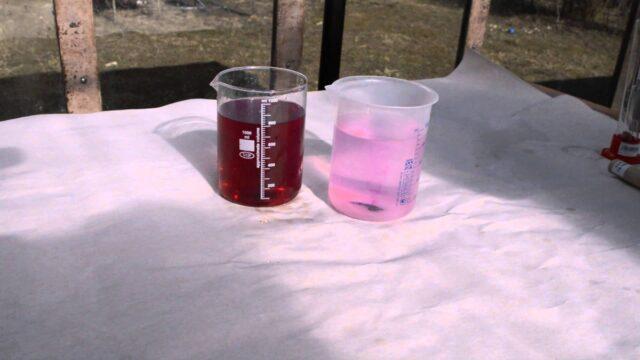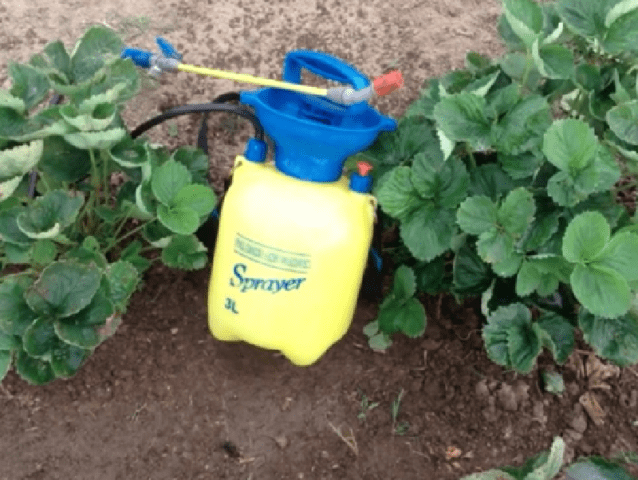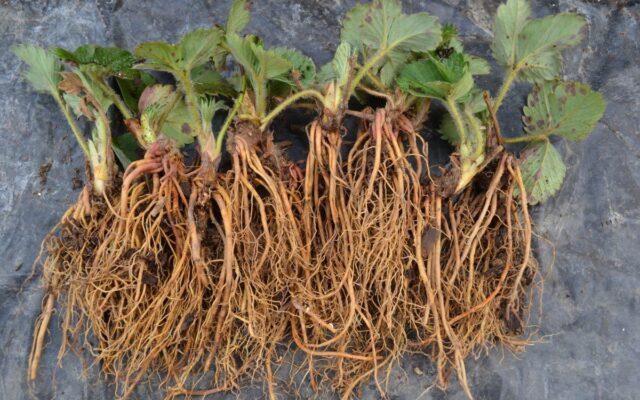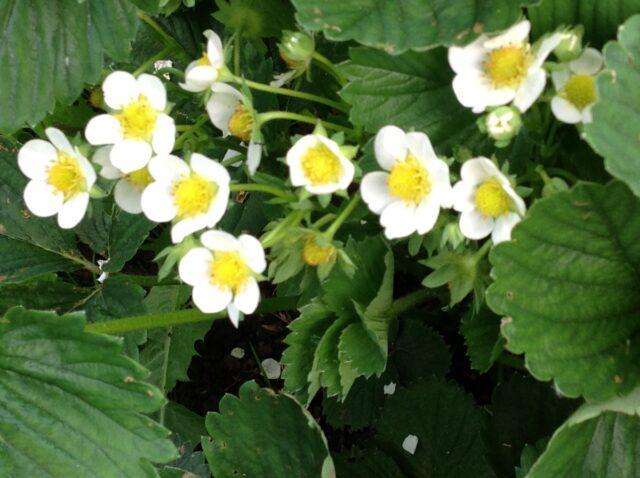Content
- 1 Is it possible to process strawberries with potassium permanganate
- 2 When to process strawberries with potassium permanganate
- 3 How to dilute potassium permanganate for processing strawberries in autumn, spring
- 4 Processing the land with potassium permanganate before planting strawberries
- 5 Processing strawberry roots with potassium permanganate before planting
- 6 How to process strawberries with potassium permanganate in spring
- 7 How to process strawberries with potassium permanganate after harvesting, pruning leaves in the fall
- 8 Conclusion
- 9 Reviews on the use of potassium permanganate for strawberries under the root in summer
Potassium permanganate for strawberries in the spring is necessary at the pre-planting stage (watering the soil, processing the roots), as well as during the flowering period (foliar feeding). The substance disinfects the soil well, but at the same time destroys beneficial bacteria. Therefore, it is used in diluted form no more than three times per season.
Is it possible to process strawberries with potassium permanganate
Potassium permanganate is an inorganic salt - potassium permanganate (KMnO4). It is also called potassium permanganate. The substance is a strong oxidizing agent. It destroys most bacteria, as well as fungal spores and insect larvae. Therefore, it functions as a fungicide and insecticide, it is used as a strong antiseptic.
In moderate concentrations, potassium permanganate does not harm plants - neither the green part, nor the fruit. Therefore, you can pour potassium permanganate on strawberries in spring or autumn. This is a good tool for the prevention and destruction of pests.
Why watering strawberries with potassium permanganate
Watering strawberries with potassium permanganate is done in spring and autumn, only 2-3 times per season. The main goal is to prevent common diseases:
- rust;
- spotting;
- fusarium;
- different types of rot;
- chlorosis.
Due to its high chemical activity, potassium permanganate totally destroys almost all microorganisms, including beneficial bacteria (when it enters the soil). Therefore, you need to use this tool carefully, carefully observing the dosage - a maximum of 5 g per 10 liters.
In addition, you should not consider potassium permanganate as a top dressing during the flowering of strawberries. Many summer residents mistakenly believe that this substance is a source of potassium and manganese. In fact, there is clearly not enough potassium in such concentrations. Better to use potassium salt or potassium sulfate. As for manganese, it is present in almost all soils. And this element is not absorbed from permanganate.

Potassium permanganate solution for watering strawberries in spring should be slightly pink, and not richly raspberry
Despite all the disadvantages, potassium permanganate remains a popular remedy because it:
- totally destroys all pathogenic bacteria and fungi;
- leads to the death of insect larvae;
- does not accumulate heavy elements in the soil (unlike a number of chemicals);
- affordable and easy to use.
When to process strawberries with potassium permanganate
Since potassium permanganate belongs to potent substances that destroy not only pests, but also beneficial bacteria and fungi, it should be used with caution. Even during foliar treatment, a significant part of the solution enters the soil. Therefore, no more than three treatments are allowed per season:
- On the eve of planting seedlings in the spring (early April), water the soil.
- Before flowering - root top dressing (end of May).
- At the first stages of the appearance of flowers (early June) - foliar feeding.
The specific timing depends on the flowering period of the strawberries, but in any case, the dosage should not be violated. You can also make the last application in the fall by watering the soil with a potassium permanganate solution. This is especially valuable for areas where the berry is supposed to be planted in the spring. In other cases, it is better to refrain from using potassium permanganate, replacing it, for example, "Fitosporin".
How to dilute potassium permanganate for processing strawberries in autumn, spring
Strawberries can be sprayed with potassium permanganate, as well as water the soil with a solution. In this case, the concentration should be very low - from 1 to 5 g per 10 liters of water. The substance is taken in small quantities. Crystals can be weighed on a kitchen scale or the concentration can be determined by eye (at the tip of a teaspoon). The resulting solution should be slightly pink in color.

It is better to work with potassium permanganate with gloves, avoid contact with eyes and skin
To obtain a solution, you must:
- Measure out a small amount of powder.
- Dissolve in a bucket of settled water.
- Mix thoroughly and proceed to watering or spraying strawberries with potassium permanganate in spring or autumn.
Processing the land with potassium permanganate before planting strawberries
Potassium permanganate is often used to cultivate the soil before planting. This can be done 1.5 months before disembarkation, i.e. in spring (early April). The soil is watered with a solution of potassium permanganate with an average concentration of 3 g per 10 liters. This amount is enough for 1 m2... For a medium-sized garden bed you will need 3-4 buckets of ready-made solution.
In the spring, the site is cleared of leaves, branches and other debris, then dug up and a little sand is added - in a bucket of 2-3 m2... It will provide a lighter soil structure, which is beneficial for strawberry roots. When watering, it retains water for a long time. Thanks to this, potassium permanganate is not washed out and has a long-term effect on bacteria.
After watering the soil in spring with potassium permanganate, it is very important to restore the microflora (beneficial bacteria) using any biological preparation, for example:
- "Baikal";
- "East";
- Extrasol;
- "Radiance";
- "Bisolbeefit".
This can be done a month after applying the potassium permanganate solution, i.e. about two weeks before planting strawberries in spring. At the same moment, it is allowed to add organic matter, but not fresh manure, but humus or compost - in a bucket per 1 m2.
Organics contain beneficial bacteria that will die due to the action of potassium permanganate. And mineral dressings (powder) are washed out due to the large amount of water.
Processing strawberry roots with potassium permanganate before planting
In the spring, before planting, strawberry roots are recommended to be treated in a special solution. Potassium permanganate is rarely used for these purposes. If there were no other means at hand, you can use potassium permanganate of low concentration - 1-2 g per 10 liters of water at room temperature. In such a liquid, the roots are kept for 2-3 hours, after which they begin to plant.

Rhizomes can be etched in potassium permanganate for two hours
Permanganate disinfects the roots well, which will allow strawberries to avoid pest damage in spring and summer. But this substance does not stimulate growth. Therefore, it is advisable to use other drugs, for example:
- Epin;
- Kornevin;
- Heteroauxin;
- "Zircon;
- herbal sourdough - infusion of the green part of nettle, legumes with superphosphate (leave to ferment for 10-15 days).
You will need 100 g of chopped cloves per liter of warm water. Compared with potassium permanganate, this is a more gentle composition.
How to process strawberries with potassium permanganate in spring
In spring and early summer, berries are treated with a solution of potassium permanganate 1 or maximum 2 times:
- Before flowering (at the root).
- When the first flowers appear (foliar treatment).
In the first case, a complex agent is used - dissolve in 10 liters of water:
- 2-3 g of potassium permanganate;
- 200 g of wood ash (powder);
- 1 tbsp. l. pharmacy iodine (alcohol solution);
- 2 g boric acid powder (also available at the pharmacy).
All this is mixed in water at room temperature and the plants are watered (0.5 liters of solution per bush). Potassium permanganate and boric acid disinfect the soil, and iodine prevents the development of a number of fungal diseases, including gray rot. Wood ash serves as a natural fertilizer, it prevents soil acidification due to the effects of boric acid and potassium permanganate. After fertilization with such a mixture, there is an increase in peduncles on all plants by 1.5–2 times.
In the second case, foliar feeding is carried out only with potassium permanganate in the amount of 2-3 g per 10 liters. The bushes are sprayed late at night or in cloudy weather. Do this in a calm and dry period. It is necessary to ensure that the solution gets on both the green part and the flowers. After that, you can carry out another spraying using the drug "Ovary", which stimulates the processes of fruit formation.
They do not store it for a long time. If there are surpluses left, they are poured into a glass container, covered with a lid and kept in the refrigerator for no more than three days.

Watering strawberries with potassium permanganate is carried out in the spring before and during flowering
How to process strawberries with potassium permanganate after harvesting, pruning leaves in the fall
At the beginning of autumn, wilted leaves are cut off, peduncles are removed. After harvesting, strawberries can also be watered with a solution of potassium permanganate, but only if:
- in the spring there was only one treatment (so as not to violate the application rate);
- plants are affected by fungal, bacterial or viral diseases.
Also, a solution of potassium permanganate is used for autumn watering of the soil in a greenhouse or in a vegetable garden - on a site where plants are supposed to be planted in spring. They do this for disinfection from fungi, insects and other pests. For the next season (one month before planting), it is imperative to add organic matter or water the soil with solutions of biological agents. Otherwise, there will be few beneficial bacteria, which will have a bad effect on the fruiting level.
It will help the culture survive the winter, as well as enrich the soil with nutrients in which they plan to plant the plants for the next season.
Conclusion
Potassium permanganate for strawberries in spring is suitable for dressing roots, seeds, and also as a foliar dressing in the early stages of flowering in late spring or early summer. To restore the microflora, after treatment, it is advisable to water the soil with a solution of a biological preparation.
Reviews on the use of potassium permanganate for strawberries under the root in summer








